 |
 |
 |
| |
Pharmacokinetics of multiple-dose darunavir in combination with low-dose ritonavir in individuals with impaired hepatic function
|
| |
| |
Reported by Jules Levin
4th IAS Conference, July 2007, Sydney, Australia
Sekar VJ,1 Spinosa-Guzman S,2 De Paepe E,2 Stevens T,2 Tomaka F,1 De Pauw M,2 Hoetelmans RM2
1Tibotec Inc, Yardley, PA, USA; 2Tibotec BVBA, Mechelen, Belgium
This study assessed the steady-state pharmacokinetics and safety of DRV/r 600/100mg bid in HIV-negative volunteers with mild and moderate hepatic impairment, compared with matched HIV-negative, healthy control volunteers, to
determine whether liver impairment affected exposure to DRV.
Abstract
Objectives: Darunavir (DRV; TMC114), a HIV protease inhibitor (PI) potent against wild-type and PI-resistant HIV, is co-administered with low-dose ritonavir (RTV; DRV/r). This study assessed the pharmacokinetics and safety of the recommended DRV/r 600/100mg bid dose in HIV-negative volunteers with mild and moderate hepatic impairment compared with matched HIV-negative, healthy control volunteers.
Methods: Hepatic impairment was defined according to Child-Pugh classification A (mild) and B (moderate). Volunteers received DRV/r 600/100mg bid for 6 days with a morning dose on Day 7. Full pharmacokinetic profiles were obtained up to 72 hours post-dose for DRV and 12 hours post-dose for RTV on Day 7. Safety and tolerability were also assessed.
Results: DRV pharmacokinetics in volunteers with mild (n=8) and moderate (n=8) liver impairment were comparable to those in healthy matched control volunteers (n=16). In those with mild hepatic impairment, relative to healthy volunteers, the least square mean (LSM) ratios (90% confidence intervals) for DRV exposure (AUC12h), maximum (Cmax) and minimum (Cmin) plasma concentrations were 0.94 (0.75-1.17), 0.88 (0.73-1.07) and 0.83 (0.63-1.10), respectively. For those with moderate hepatic impairment, LSM ratios for AUC12h, Cmax and Cmin were 1.20 (0.90-1.60), 1.22 (0.85-1.56) and 1.27 (0.87-1.85), respectively, relative to healthy volunteers. RTV pharmacokinetics were comparable between healthy volunteers and those with mild liver impairment. In volunteers with moderate liver impairment, mean RTV exposure was approximately 50% higher than in healthy volunteers. DRV/r treatment was generally well tolerated, regardless of liver impairment level. All adverse events were grade 1-2 in severity except for one grade 3 increase in alanine aminotransferase. No adverse events led to discontinuation.
Conclusions: Dose adjustments of DRV/r are not necessary in individuals with mild or moderate liver impairment. Usual clinical monitoring of individuals with mild to moderate hepatic impairment receiving DRV/r is considered adequate.
Author Conclusions
- Following treatment with DRV/r 600/100mg bid, DRV pharmacokinetics in volunteers with mild and moderate liver impairment were comparable with those in healthy matched control volunteers.
- RTV pharmacokinetics in volunteers with mild liver impairment were comparable to those in healthy volunteers, while the mean RTV exposure
(AUC12h) was approximately 50% higher and RTV Cmin was increased by
approximately two-fold in volunteers with moderate liver impairment
compared with healthy volunteers.
- All AEs were grade 1-2 in severity except for one grade 3 increase in ALT in a volunteer with mild hepatic impairment. No serious AEs or AEs leading to discontinuation were reported.
- Dose adjustments of DRV/r are not necessary in individuals with mild or moderate liver impairment. Usual clinical monitoring of individuals with mild to moderate liver impairment receiving DRV/r is considered adequate.
Methods
- This Phase I, open-label, parallel, controlled, sequential study (TMC114-C134) was designed to investigate the steady-state pharmacokinetics of DRV/r in HIV negative volunteers with mild and moderate liver impairment, in comparison with HIV-negative healthy volunteers. Short-term safety and tolerability were evaluated throughout the study.
- Volunteers were male or female, aged 18-60 years. Major exclusion criteria for all volunteers included a positive HIV-1 or HIV-2 test at screening; acute hepatitis; or any currently active, clinically significant disease (excluding liver disease for those with mild or moderate hepatic impairment)
--healthy volunteers could not have chronic hepatitis B or C or any predefined
liver-related laboratory abnormalities at screening
--volunteers with hepatic impairment had to have a history of hepatic disease and liver function impairment according to the Child-Pugh A or B classifications.9 The main exclusion criteria for volunteers with hepatic impairment were: hepatic decompensation; grade 3 or 4 encephalopathy (Child-Pugh classification); hepatic carcinoma; or candidacy for liver transplantation.
- Use of medication other than that used by volunteers for the management of mild and moderate liver impairment condition had to be discussed prior to inclusion on an individual basis except for paracetamol (acetaminophen).
- The 32 volunteers were divided into two panels
-- Panel A: eight volunteers with mild hepatic impairment (Child-Pugh A) and eight healthy matched controls based on age (±5 years), body weight
(±15%), and gender
-- Panel B: eight volunteers with moderate hepatic impairment (Child-Pugh B)
and eight healthy matched controls based on age (±5 years), body weight (±15%), and gender.
- Volunteers received DRV/r 600/100mg bid for 6 days with a morning
dose on Day 7. The volunteers also received RTV 100mg on the evening of Day 7 and in the morning and evening of Days 8 and 9. All treatments were administered with standardised meals. Recruitment of volunteers with moderate hepatic impairment began only after no major safety concerns had been observed during the treatment of volunteers with mild hepatic impairment.
- Full pharmacokinetic (PK) profiles of DRV and RTV were determined on Day 7 up to 72 hours post-dose for DRV and 12 hours post-dose for RTV, using liquid
chromatographic-mass spectrometry/mass spectrometry.
- Statistical analysis for DRV compared volunteers with mild (Panel A) or moderate (Panel B) liver impairment (test) versus healthy matched volunteers (reference) within the same panel. The primary PK parameters were minimum plasma concentration (Cmin), maximum plasma concentration (Cmax) and area under the plasma concentration-time curve from administration up to 12 hours post-dose (AUC12h) on the logarithmic scale. The least square means (LSM) of the primary parameters from each panel were estimated with a linear mixed effects model with treatment as fixed effect and individual as a random effect. Confidence intervals (CIs) of 90% were constructed around the difference between the LSM of test and reference.
RESULTS
Participant disposition
- All 32 volunteers completed the study.
- There were no relevant demographic differences within either panel (Table 1).
- All volunteers with liver impairment presented with currently active diseases at screening. None of these comorbidities were considered to have an influence on the outcome of the trial.
Table 1. Volunteer demographics.
4/8 in mild group had cirrhosis and 2/8 in moderate liver impairment group had cirhhosis.
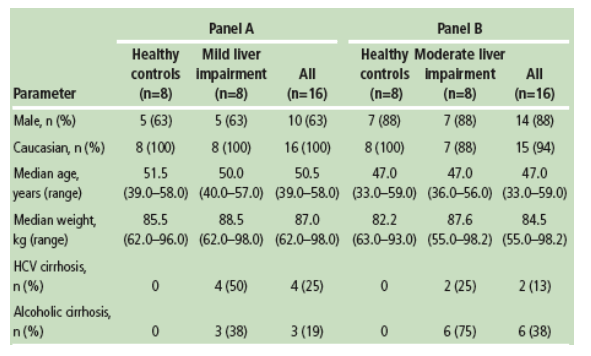
Pharmacokinetics of DRV
The mean DRV PK profiles in volunteers with mild or moderate liver impairment
compared with those of healthy matched controls on Day 7 of combined
treatment are shown in Figures 1a and 1b, respectively.
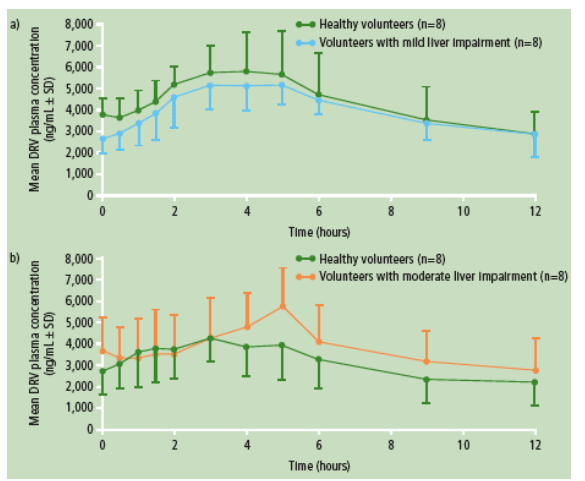
Figure 1. Mean (standard deviation [SD]) DRV plasma concentration-time curves on Day 7 for
a) volunteers with mild liver impairment compared with healthy volunteers (Panel A) and
b) volunteers with moderate liver impairment compared with healthy volunteers (Panel B).
- PK parameters and statistical analyses for DRV are summarised in Table 2
-- relative to healthy volunteers, LSM ratios for DRV Cmin, Cmax and AUC12h were 0.83, 0.88 and 0.94, respectively, in volunteers with mild liver impairment
-- in volunteers with moderate liver impairment, LSM ratios for DRV Cmin, Cmax and AUC12h were 1.27, 1.22 and 1.20, respectively, relative to healthy volunteers.
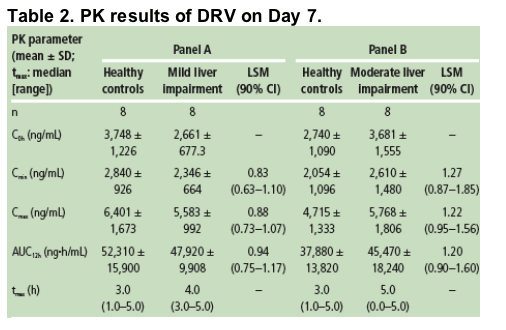
Pharmacokinetics of RTV
RTV pharmacokinetics on Day 7 were comparable between healthy volunteers and those with mild liver impairment (Figure 2a and Table 3). In volunteers with moderate liver impairment, RTV plasma concentrations were increased relative to those of healthy volunteers (Figure 2b).
In volunteers with moderate liver impairment the mean AUC12h of RTV was approximately 50% higher compared with healthy volunteers, and RTV Cmin was increased by approximately two-fold (Table 3).
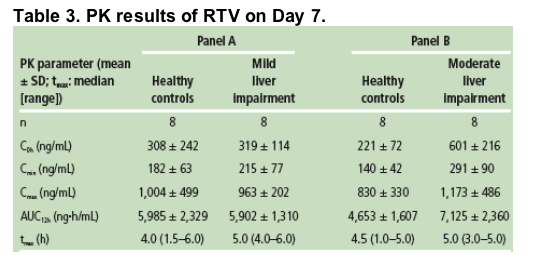
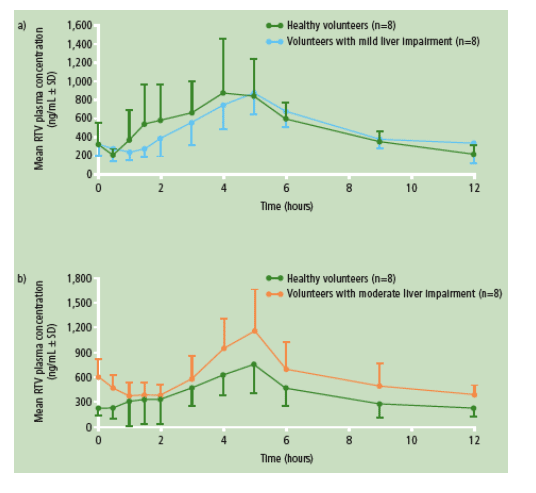
Figure 2. Mean (SD) RTV plasma concentration-time curves on Day 7 for a) volunteers with mild liver impairment compared with healthy volunteers (Panel A) and b) volunteers with moderate liver impairment compared with healthy volunteers (Panel B).
Safety and tolerability
- The incidence of adverse events (AEs) was similar within each panel during treatment with DRV/r
--in Panel A, six volunteers with mild liver impairment and four healthy volunteers reported at least one AE
--in Panel B, four volunteers with moderate liver impairment and three healthy volunteers reported at least one AE.
- The most commonly reported AEs during DRV/r treatment in volunteers with mild liver impairment were increased alanine aminotransferase (ALT), increased aspartate aminotransferase and headache, each reported in two volunteers; these were also each reported in two healthy volunteers (except for headache which occurred in three).
- Individual AEs were not reported in more than one volunteer with moderate liver impairment during DRV/r treatment, except for fatigue, which was reported in two volunteers (fatigue was not reported in healthy volunteers).
- All AEs were grade 1-2 in severity except for one grade 3 increase in ALT reported for one volunteer with mild liver impairment (with mild liver cirrhosis secondary to alcoholism).
- No serious AEs were reported during the study and no volunteers prematurely discontinued treatment due to an AE.
- No consistent or clinically relevant changes in laboratory parameters were observed. Most treatment-emergent laboratory abnormalities were grade 1 or 2 in severity and no grade 4 abnormalities were observed during DRV/r treatment.
References
1. De Meyer S, et al. Antimicrob Agents Chemother 2005;49:2314-21.
2. Katlama C, et al. AIDS 2007;21:395-402.
3. Haubrich R, et al. AIDS 2007;21:F11-F18.
4. Clotet B, et al. Lancet 2007;369:1169-78.
5. Tibotec Inc. PREZISTATM (darunavir) Prescribing Information. October 2006 (accessed 21 May 2007).
Available from: http://www.prezista.com.
6. PREZISTATM (darunavir) Summary of Product Characteristics. February 2007 (accessed 21 May 2007). Available from: http://www.emea.eu.int/humandocs/Humans/EPAR/prezista/prezista.htm.
7. Sekar V, et al. 16th International AIDS Conference, Toronto, Canada, 13-18 August 2006. Abstract TUPE0083.
8. Bica I, McGovern B, Dhar R, et al. Clin Infect Dis 2001;32:492-7.
9. Pugh RNH, et al. Br J Surg 1973;60:646-9.
|
| |
|
 |
 |
|
|